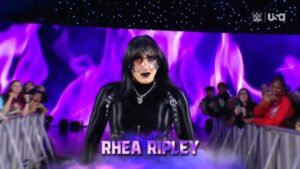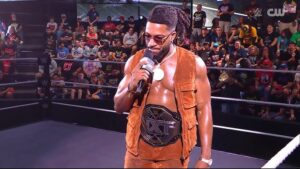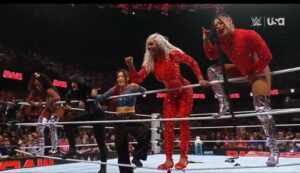In a moment that was both shocking, nostalgic, and exciting all at the same time, “The Icon” Sting returned to pro wrestling television for the first time since appearing on Monday Night Raw for Ric Flair‘s 70th Birthday back in February of 2019 (before that appearance, it hadn’t been since 2016). The 14x World Champion (2x NWA, 6x WCW, 2x WCW International, 4x TNA/IMPACT) made his presence known at Daily’s Place in Jacksonville, Florida on Wednesday’s AEW Dynamite, at the conclusion of the match between Cody Rhodes & Darby Allin versus Team Taz‘ Ricky Starks & Powerhouse Hobbes. It was then quickly revealed that Sting had signed a multi-year contract with All Elite Wrestling, revealing his return to the TNT Network on-going in nearly 20 years – he faced Flair on the final edition of Monday Nitro in March 2001, when it was revealed Vince McMahon had purchased the company. With his return to TNT and debut with AEW on December 2, 2020, it becomes yet another milestone in the now 35-year career of the Man Called Sting.
.@STING HAS ARRIVED IN ALL ELITE WRESTLING!
Watch #AEWDynamite NOW on @TNTDrama pic.twitter.com/NMLGKqdQtX— All Elite Wrestling (@AEW) December 3, 2020
Like many pro wrestlers in the 1980s, Steve Borden – the man beneath the paint – came from a bodybuilding background. Originally scouted and trained with several other bodybuilders – including a man named Jim Hellwig – by Red Bastien and Rick Bassman, he debuted in the group called Powerteam USA in All-California Championship Wrestling (ACCW) in 1985. ACCW was an independent promotion outside of the National Wrestling Alliance (NWA), before jumping to the NWA’s Memphis territory, Continental Wrestling Association (CWA), run by Jerry Jarrett and Jerry “The King” Lawler, where Hellwig and Borden were repackaged as The Freedom Fighters, with Borden becoming Flash and Hellwig becoming Justice. By the end of 1985, they were rebranded again, this time as The Blade Runners, with Borden becoming Blade Runner Sting and Hellwig Blade Runner Rock. In their third team incarnation, they appeared in make-up similar to the likes of The Road Warriors. By 1986, they jumped to Mid-South Wrestling, which had recently been rebranded itself as the Universal Wrestling Federation (UWF). Hellwig would leave UWF for Fritz Von Erich‘s World Class Championship Wrestling (WCCW) only six months later – where he became The Dingo Warrior – leaving Sting by himself in UWF. By June of 1987, Hellwig landed in the WWF and became The Ultimate Warrior, striking stardom slightly earlier than his former tag team partner.
In a defensive move to compete against Vince McMahon’s territorial acquisitions in recent years, such as Georgia Championship Wrestling, Stampede Wrestling, Maple Leaf Wrestling, and Montreal’s Lutte International, Jim Crockett Jr. from Mid-Atlantic Championship Wrestling in the NWA began acquiring territories of his own to compete with McMahon’s growing empire. Starting in 1985, Crockett started acquiring new regions, buying out Ole Anderson‘s Championship Wrestling From Georgia (the successor to GCW), Sam Muchnik & Harley Race‘s St. Louis Wrestling Club, Bob Geigel‘s NWA Central States, and Eddie Graham‘s Championship Wrestling From Florida. In April 1987, just months before Hellwig joined WWF as Ultimate Warrior, Crockett purchased the UWF territory from Bill Watts, acquiring the contract for Sting. By July, Crockett’s booker, former NWA World Champion Dusty Rhodes, had taken a shine to the young painted star and decided to push him in the opening match of NWA Starrcade ’87, where he teamed with Fabulous Freebirds’ Michael PS Hayes and “Gorgeous” Jimmy Garvin in 6-man action against Larry Zybszyko, Rick Steiner & Eddie Gilbert. By March of 1988, Sting was facing off against Ric Flair for the NWA World’s Heavyweight Championship ay NWA Clash of Champions. NWA had found its next brightest new star.
Sting and his former tag partner, Ultimate Warrior, saw their career trajectory rise at a similar pace early on – by the end of 1989, Warrior was a 2x WWF Intercontinental Champion and Sting was an NWA World Television Champion. In April of 1990, Warrior defeated the face of the WWF, Hulk Hogan, to win the WWF World Heavyweight Championship at WrestleMania VI, while three months later at NWA Great American Bash ’90, Sting defeated Flair for the NWA World’s Heavyweight Championship. The Blade Runners were now atop of the top two promotions in the United States. But it would soon become clear who the better of the two prospects would turn out – by 1992, Warrior had worn out his welcome with the WWF and had practically left the business. Meanwhile, Sting had won his first WCW United States Championship and by the time Warrior wrestled his last WWF match in November of 1992 (in a house show against Kamala), Sting had already captured his second World Championship (and first WCW World Heavyweight Championship) and was several months away from winning his second WCW World title.
In 1994, he would capture the WCW International World Heavyweight Championship (the Big Gold belt born out of WCW seceding from the NWA in 1993), a secondary World Championship that was used primarily for international contests, primarily in Japan in competitions against then-ally New Japan Pro Wrestling (NJPW). Sting had a monstrous feud against Rick Rude over the title that spanned from the US to Japan and was in his second reign when it was unified with the WCW World Heavyweight Championship in June of 1994 (the new WCW World title would continue with the Big Gold design). During the early 1990s, Sting became one of WCW’s biggest stars. But like many overly colorful characters left over from the 1980s, by the mid-90s, the new audience was demanding something edgier. They wanted something darker. And Sting was only too happy to oblige. He began to grow his normally short-cropped surfer do out, growing darker to his natural brown, with large scorpions appearing on his tights. He joined with his old friend Lex Luger and captured the WCW World Tag Team Championships. But when Scott Hall, Kevin Nash, and ultimately Hulk Hogan, created the New World Order (nWo) in 1996, Sting seemed to be losing steam and momentum. Was WCW’s Golden Boy destined to become a relic so soon? Rumors abound that Sting was going to join the nWo, which caused tension amongst Sting and his friends on Nitro, until finally by the end of the year, Sting had had enough and disappeared.
Throughout early 1997, Sting was eerily quiet, but when he began to re-appear, it was not to fight in-ring. He was spotted in shadows and in the rafters, with a ghostly new face paint that was more akin to Brandon Lee’s Crow character than any resemblance of the Blade Runners make-up that he had shared with Warrior. For nearly the entire year of 1997, Sting was quiet, omniscient, and mesmerizing. Without saying a word or throwing a fist, this new twisted version of Sting became one of the year’s most exciting new characters, culminating in Sting ultimately returning to WCW to fend off the nWo infection of WCW, finally defeating “Hollywood” Hulk Hogan at Starrcade ’97 for his third WCW World title. Not only was Sting back, but as WCW became a TV juggernaut that defeated WWF in TV ratings for 83 weeks, Sting was bigger than ever before. Sting would ultimately join the nWo – at least, a version of the nWo – when he joined the “cool face” version called the nWo Wolfpack, when nWo’s “Macho Man” Randy Savage helped Sting regain the WCW World title at Super Brawl VIII in early 1998 before joining Nash, Savage, Hall, and Luger in Wolfpack that Spring. Sting would continue to be one of WCW’s elite level main event stars until its bitter end, competing on Nitro‘s final telecast in 2001. By the time WCW was over, Sting was a 6x WCW World Champion.
When WCW was purchased by Vince McMahon, Sting’s contract was not one of the ones McMahon acquired – like many other main event stars, Sting’s contract was with Time Warner, not WCW itself. Sting road out his WCW contract and when he became a free agent in 2003, he rebuffed offers from WWE to join them and instead signed with upstart Total Nonstop Action (TNA), debuting on in June 2003 at the TNA 1st Anniversary Show (which would eventually become Slammiversary). But Sting’s first run with TNA was short lived – he only signed a small appearance run and by the Spring of 2004, he was gone. He would make his shocking return with a vignette at TNA Turning Point in December of 2005, arriving back in a TNA ring in January of 2006. That October, he would defeat Jeff Jarrett at TNA Bound for Glory ’06 to win his second NWA World’s Heavyweight Championship, further adding to his legacy. Much like after his first NWA World title win, soon after holding the title, the company would secede from the NWA, but that didn’t stop Sting’s hunt for championship gold – the following year, at TNA Bound for Glory ’07, he defeated Kurt Angle for his first TNA/IMPACT World Heavyweight Championship.
Bound for Glory proved to be a lucky event for Sting, and at TNA Bound for Glory ’08, he would win his third TNA World title – with the help of former Wolfpack member Kevin Nash – by defeating Samoa Joe, and after the victory, formed The Main Event Mafia with Nash, Angle, and Booker T. Soon after, Scott Steiner would join the group, who also saw brief inductions of Christian Cage and Samoa Joe. Sting left the group the following June in 2009. Sting continued to be a locker room leader and main event player on TNA television, and in 2011 his character would morph once again, when “Joker Sting” emerged – a character that combined the early darkness of “Crow Sting” with lunacy inspired by Heath Ledger’s portrayal of The Joker in 2008’s The Dark Knight. That proved to be another big year for Sting, who captured his third and fourth TNA World Championships. In 2014, his contract came up, and Sting departed TNA after a solid eight-year run that saw him add five more World titles to his resume.
Once again a free agent, this time the stars finally aligned and Sting finally signed with WWE. He initially began appearing on programming on the WWE Network, before being announced for WWE 2K15 as a pre-order bonus, but it was at Survivor Series ’14 that he made his on-screen impact. He interfered in The Authority‘s match at the WWE PPV, attacking Triple H and putting him in a Scorpion Deathlock. Soon, Sting began to appear regularly on WWE programming, costing Authority members matches, and getting under Triple H’s skin. These provocations lead to Sting finally making his in-ring debut at WrestleMania 31 in a rather polarizing match against Triple H, which ended up seeing members of the nWo coming to back Sting and D-Generation X backing Triple H.
What was supposed to be a one-off turned into something more, as fans were excited at the prospects of seeing Sting compete regularly in a WWE ring after so many years of avoiding the company. He would continue to pester members of the Authority, facing The Big Show in September on RAW before teaming with John Cena against Big Show and Seth Rollins, the WWE World Champion. It culminated in Sting’s first and last challenge for the WWE World Heavyweight Championship, facing Seth Rollins at WWE Night of Champions ’15. Sting lost the match, but more importantly, was severely injured. With a severe injury, at 56 years old, it appeared that Sting’s WWE dream run was over. The announcement in January of 2016 that Sting was the headliner for the WWE Hall of Fame Class of 2016 seemed a formality for the inevitable, and in April of 2016, at his Hall of Fame induction speech, Sting officially announced his retirement from pro wrestling. He quietly returned to the shadows and remained under contract with the WWE as an Ambassador, appearing at conventions on the WWE’s behalf. It seemed that Sting’s career was now officially over and that it sadly had come to its closure with a whimper and somewhat lackluster run in the WWE.
But in the spring of 2020, things began to get interesting. Mattel, makers of WWE Action Figures, announced that the previously announced Sting Legends figured had been abruptly pulled from production due to circumstances out of Mattel’s control. Rumors flew rampant that Sting’s WWE deal had expired and the two sides had not come to an agreement. But these things happen all the time. Could just be a temporary business glitch, similar to when Drew Gulak left – and then re-signed with – WWE earlier this same year. But in October, just days before Halloween (a solid holiday for Sting merch), WWE completely removed Sting’s store on its WWEShop website. It appeared that not only had the two sides not agreed on any extension, WWE now had no legal recourse to sell Sting merchandise. It would appear that Sting was once again a free agent. But he had retired though, right?
— Cody Rhodes (@CodyRhodes) May 11, 2020
Well, that’s what we all thought. Yet here we are, in December of 2020, and we’ve just witnessed the return to the small screen, on a professional wrestling program on the TNT Network no less, a man who became one of the 1990s biggest stars, an icon in the 2000s, and now appears in AEW as a Living Legend (sorry, Larry!). And with word that Sting has signed a multi-year deal, it would appear that Sting has returned to the very world he had declared his departure from just over four years ago. And you can bet he’s probably got at least one more match in him – perhaps against the son of the man who got him his first big break in the NWA when he was merely a rejected Blade Runner.
Stay tuned to Last Word on Pro Wrestling for more on this and other stories from around the world of wrestling, as they develop. You can always count on LWOPW to be on top of the major news in the wrestling world, as well as to provide you with analysis, previews, videos, interviews, and editorials on the wrestling world. You can catch AEW Dynamite Wednesday nights at 8 PM ET on TNT and AEW DARK Tuesday nights at 7 PM ET on YouTube.
Looking to talk wrestling, pro football, or any number of sports? Head on over to the LWOS Boards to engage in conversation with fellow fans!






